Structural Efficiency Analysis of a Piston for Aviation Engines
Abstract
:1. Introduction
2. Connotation of Structural Efficiency
2.1. Maximum Load of Piston under Thermal–Mechanical Coupling
2.2. Fatigue Deformation of Piston Pin Bore under Multiple Fields
2.3. Emission Performance
3. Structural Efficiency Calculation of the Piston
3.1. Maximum Bearing Capacity of the Piston
3.2. Deformation of Piston Pin Bore
3.3. Emission Performance
4. Calculation of Piston Structure Efficiency
- (1)
- Each single-state sub-parameter was calculated and normalized to obtain the normalized value.
- (2)
- Using multiplication operation, the normalized values of single-state sub-parameters were synthesized to obtain full-state sub-parameters.
- (3)
- The multiplication operation was used to synthesize the full-state sub-parameters to obtain the corresponding parameter terms.
- (4)
- The structural efficiency of the piston can be obtained by adding and integrating all parameter items.
5. Experiment
- It was installed on the engine test bench according to the AVL analyzer and smoke meter instructions.
- The engine was started, the oil temperature was allowed to reach 80 °C, and then emissions data were measured under different RPM.
- The sampling tube of the AVL di-test gas 1000 analyzer was inserted into the engine exhaust pipe and the data were read.
- After the measurement, the air pump should keep working for 10 min to clean the internal pipeline of the AVL di-test gas 1000 analyzer.
6. Conclusions
- (1)
- Based on the role of the piston in engine performance, the connotation of piston structure efficiency was deeply analyzed. The parameter system of piston structure efficiency evaluation was established based on the maximum load of the piston under thermal–mechanical coupling, fatigue deformation of the piston pin bore under multiple fields, and the emission performance index. The direction of piston structure optimization was pointed out through the quantitative calculation and analysis of the evaluation parameters.
- (2)
- Based on the normalized formula of the evaluation parameters and the corresponding algorithm, the calculation method of the piston structure efficiency coefficient was established. This method makes the evaluation process clearer, and finally quantifies the evaluation results into a numerical value, which directly reflects the performance parameters affected by the piston and provides a reference for different structural design schemes from an overall perspective.
- (3)
- Through the calculation and analysis of the piston structure efficiency, the structural efficiency of the two schemes was compared. The results showed that the maximum bearing capacity index of the piston in scheme 1 was 2.3% lower than that in scheme 2, the piston pin hole deformation in scheme 1 was 33.2% lower than that in scheme 2, and the emission performance index in scheme 1 was 54% higher than that in scheme 2. After comprehensive consideration, the calculation results of scheme 2 was better compared to scheme 1. Subsequent tests have proven that the rationality of the scheme 2 design verifies that the proposed structural efficiency evaluation method has high applicability in piston design.
Author Contributions
Funding
Data Availability Statement
Acknowledgments
Conflicts of Interest
References
- Zhao, Z.F.; Cui, H.S. Numerical investigation on combustion processes of an aircraft piston engine fueled with aviation kerosene and gasoline. Energy 2022, 239, 122264. [Google Scholar] [CrossRef]
- Pan, Z.; He, Q.; Zhang, X.; Zhang, D. Numerical simulation of 2-stroke diesel engine for light aircraft. IEEE Aerosp. Electron. Syst. Mag. 2015, 30, 4–10. [Google Scholar] [CrossRef]
- Kikuhara, K.; Koeser, P.S.; Tian, T. Effects of a cylinder liner microstructure on lubrication condition of a twin-land oil control ring and a piston skirt of an internal combustion engine. Tribol. Lett. 2022, 70, 6. [Google Scholar] [CrossRef]
- Zhongjian, P.; Yi, Z. Numerical investigation into high cycle fatigue of aero kerosene piston engine connecting rod. Eng. Fail. Anal. 2022, 120, 105028. [Google Scholar]
- Antonio, P.C.; Antonio, F.; Gianluca, T. Performance optimization of a two-stroke supercharged diesel engine for aircraft propulsion. Energy Convers. Manag. 2016, 122, 279–289. [Google Scholar]
- Enrico, M.; Giuseppe, C.; Carlo, A.R. Combustion system development of an opposed piston 2-stroke diesel engine. Energy Procedia 2017, 126, 1003–1010. [Google Scholar]
- Alberto, R.C.; Mattarelli, E.; Golovitchev, V. CFD analyses on 2-stroke high speed diesel engines. SAE Int. J. Engines 2011, 4, 2240. [Google Scholar]
- Mattarelli, E.; Paltrinieri, F.; Perini, F.; Rinaldini, C.A.; Wilksch, M. 2-Stroke Diesel Engine for Light Aircraft: IDI vs. DI Combustion Systems; SAE Technical Paper; SAE: Warrendale, PA, USA, 2010. [Google Scholar]
- Mattarelli, E.; Rinaldini, C.A.; Cantore, G.; Baldini, P. 2-Stroke Externally Scavenged Engines for Range Extender Applications; SAE Technical Paper; SAE: Warrendale, PA, USA, 2012. [Google Scholar]
- Carlucci, A.P.; Ficarella, A.; Laforgia, D.; Renna, A. Supercharging system behavior for high altitude operation of an aircraft 2-stroke Diesel engine. Energy Convers. Manag. 2015, 101, 470–480. [Google Scholar] [CrossRef]
- Wang, Y.; Li, Y.T.; Yang, J.; Feng, R.H. Effects of anodic oxidation for combustion chamber on heat transfer of the piston in an aero-engine. Exp. Heat Transf. 2017, 30, 46–65. [Google Scholar] [CrossRef]
- Khan, S.; Panua, R.; Bose, P.K. Combined effects of piston bowl geometry and spray pattern on mixing, combustion and emissions of a diesel engine: A numerical approach. Fuel 2018, 225, 203–217. [Google Scholar] [CrossRef]
- Yang, H.; Wang, Y.; Wang, X.C.; Cen, Q.H.; Yu, X.H. Strengthening mechanism and thermal deformation behavior of Al-12Si/Fe piston composite. Mater. Res. Express 2020, 7, 016596. [Google Scholar] [CrossRef]
- Singh, R.C.; Chaudhary, R.; Pandey, R.K. Experimental studies for the role of piston rings’ face profiles on performance of a diesel engine fueled with diesel and jatropha based biodiesel. J. Sci. Ind. Res. 2012, 71, 57–62. [Google Scholar]
- Wu, J.; Duan, S.L.; Wei, L.D.; Yan, J. Strength analysis in piston crown of the marine diesel engine. J. Eng. Res. 2013, 1, 251–269. [Google Scholar]
- Hong, J.; Li, T.R.; Zheng, H.Q.; Ma, Y.H. Applications of structural efficiency assessment method on structural-mechanical characteristics integrated design in aero-engines. Chin. J. Aeronaut. 2020, 33, 1260–1271. [Google Scholar] [CrossRef]
- Jegley, D.C.; Wu, K.C.; Phelps, J.E.; McKenney, M.J.; Oremont, L. Structural efficiency of composite struts for aerospace applications. J. Spacecr. Rockets 2012, 49, 915–924. [Google Scholar] [CrossRef]
- Rao, X.; Sheng, C.X.; Guo, Z.W. A review of online condition monitoring and maintenance strategy for cylinder liner-piston rings of diesel engines. Mech. Syst. Signal Process. 2022, 165, 108385. [Google Scholar] [CrossRef]
- Wang, W.R.; Lu, Y.; Li, Z.Y. Simulations of engine knock flow field and wave-induced fatigue of a downsized gasoline engine. Int. J. Engine Res. 2021, 22, 554–568. [Google Scholar] [CrossRef] [Green Version]
- Deulgaonkar, V.R.; Ingolikar, N.; Borkar, A.; Ghute, S. Failure analysis of diesel engine piston in transport utility vehicles. Eng. Fail. Anal. 2021, 120, 105008. [Google Scholar] [CrossRef]
- Mechalikh, M.; Benhammou, A.; Zidane, I.; Bettahar, A. Study of piston thermo-elastic behavior under thermomechanical solicitations. Int. J. Automot. Mech. Eng. 2019, 16, 7287–7298. [Google Scholar] [CrossRef] [Green Version]
- Caldera, M.; Massone, J.M.; Martinez, R.A. Failure Analysis of a Damaged Direct Injection Diesel Engine Piston. J. Fail. Anal. Prev. 2017, 17, 979–988. [Google Scholar] [CrossRef]
- Karagoz, Z.B.A.; Demirtas, S.; Kaleli, H. Review of tribological behavior of graphene coatings on piston rings in engines. Ind. Lubr. Tribol. 2020, 72, 243–254. [Google Scholar] [CrossRef]
- Pan, Z.J.; He, Q.H. High cycle fatigue analysis for oil pan of piston aviation kerosene engine. Eng. Fail. Anal. 2015, 49, 104–112. [Google Scholar] [CrossRef]
- Wang, Y.Q.; Liu, Y.Y.; Yu, S.W. Experimental study of piston ring-liner lubrication performance considering particles. J. Harbin Eng. Univ. 2021, 42, 833–838. (In Chinese) [Google Scholar]
- Storace, A.F. Turbine engine structural efficiency determination. In Proceedings of the 25th Joint Propulsion Conference, Monterey, CA, USA, 12–16 July 1989; AIAA: Reston, VA, USA, 1989. [Google Scholar]
- Svante, Y. Industry performance and structural efficiency measures: Solutions to problems in firm models. Eur. J. Oper. Res. 2000, 121, 164–174. [Google Scholar]
- Kumar, A.; Kumar, R.; Das, V. Assessing the structural efficiency and durability of burnt clay bricks incorporating fly ash and silica fume as additives. Constr. Build. Mater. 2021, 310, 125233. [Google Scholar] [CrossRef]
- Yu, P.C.; Zhang, D.Y.; Ma, Y.H. Dynamic modeling and vibration characteristics analysis of the aero-engine dual-rotor system with Fan blade out. Mech. Syst. Signal Process. 2018, 106, 158–175. [Google Scholar] [CrossRef]
- Hong, J.; Li, T.; Liang, Z.; Zhang, D.; Ma, Y. Research on Blade-Casing Rub-Impact Mechanism by Experiment and Simulation in Aeroengines. Shock. Vib. 2019, 2019, 3237960. [Google Scholar]
- Peng, G.; Li, C.; Zheng, H.Q.; Ma, Y.; Hong, J. Quantitative Analysis Method of Whole Aero-Engine Structural Design Based on Structural Efficiency. In Proceedings of the 10th International Conference on Rotor Dynamics, Rio de Janeiro, Brazil, 23–27 September 2018. [Google Scholar]
- John, B. Heywood. Internal Combustion Engine Fundamentals, 2nd ed.; McGraw-Hill: New York, NT, USA, 2018; pp. 868–932. [Google Scholar]
- Pan, Z.; He, Q.; Yang, J. Structural efficiency of block for aviation piston heavy fuel engine. Aircr. Eng. Aerosp. Technol. 2022, 94, 1327–1335. [Google Scholar]
- Pan, Z.; Guo, L. Failure analysis of the pin bore of the combined piston for the aero engine. Int. J. Aerosp. Eng. 2019, 2019, 7693403. [Google Scholar]
- Pan, z.; Deng, Y.; Cheng, L. Regular analysis of aero-diesel piston engine between combustion chamber size and emission. Int. J. Aerosp. Eng. 2019, 2019, 8690906. [Google Scholar]
- Perpignan, A.A.V.; Tomasello, S.G.; Rao, A.G. Evolution of Emission Species in an Aero-Engine Turbine Stator. Aerospace 2021, 8, 11. [Google Scholar] [CrossRef]
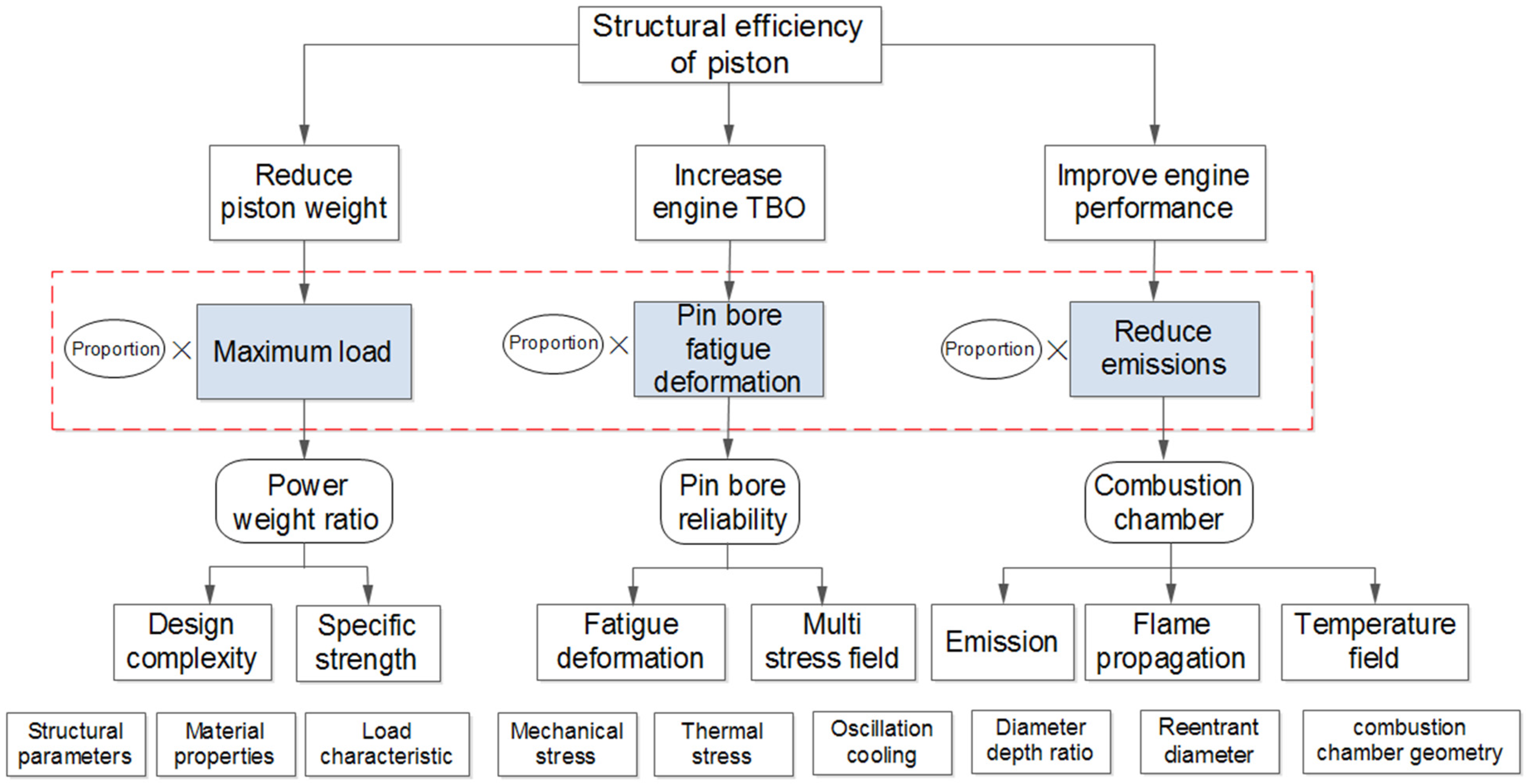
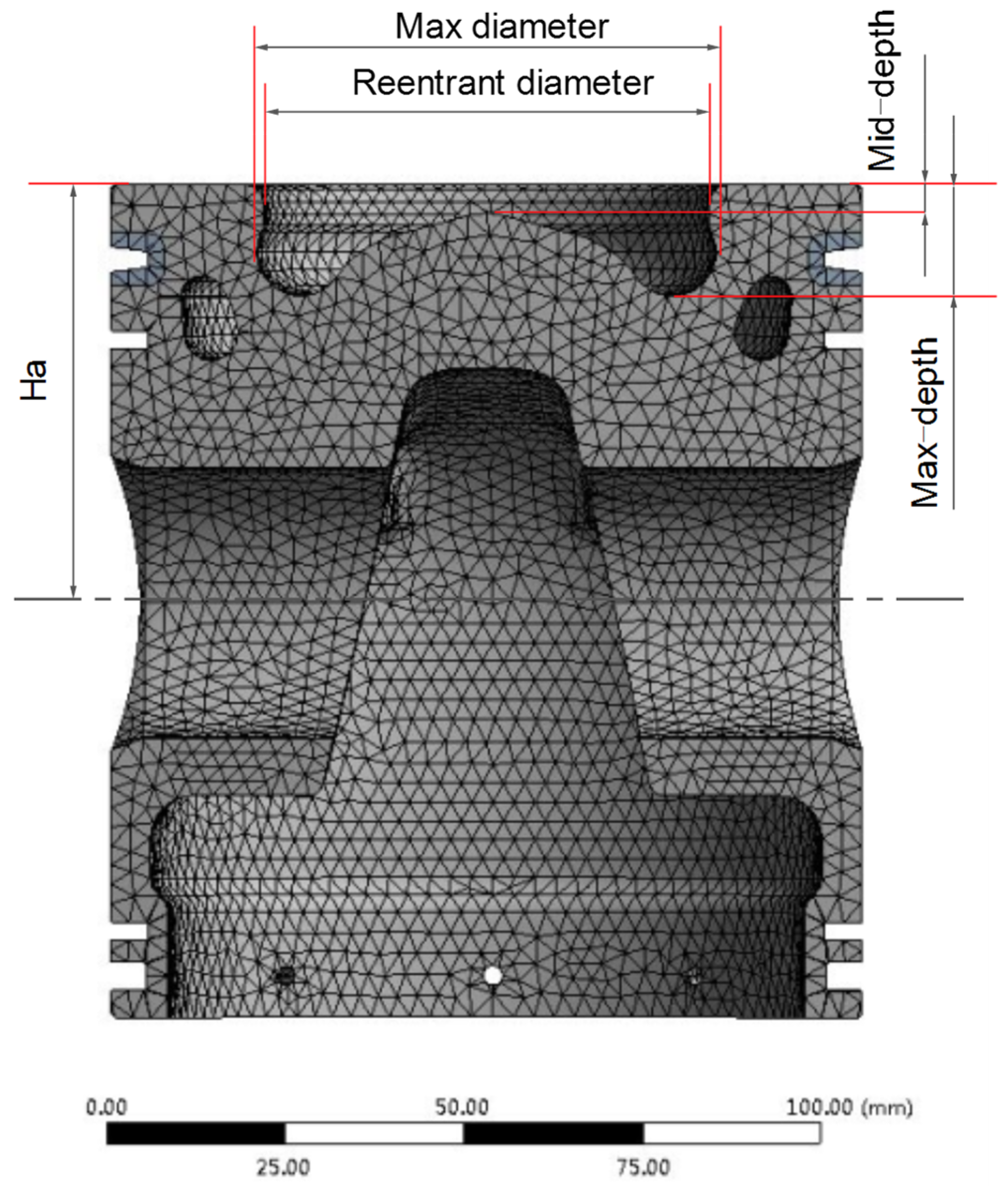
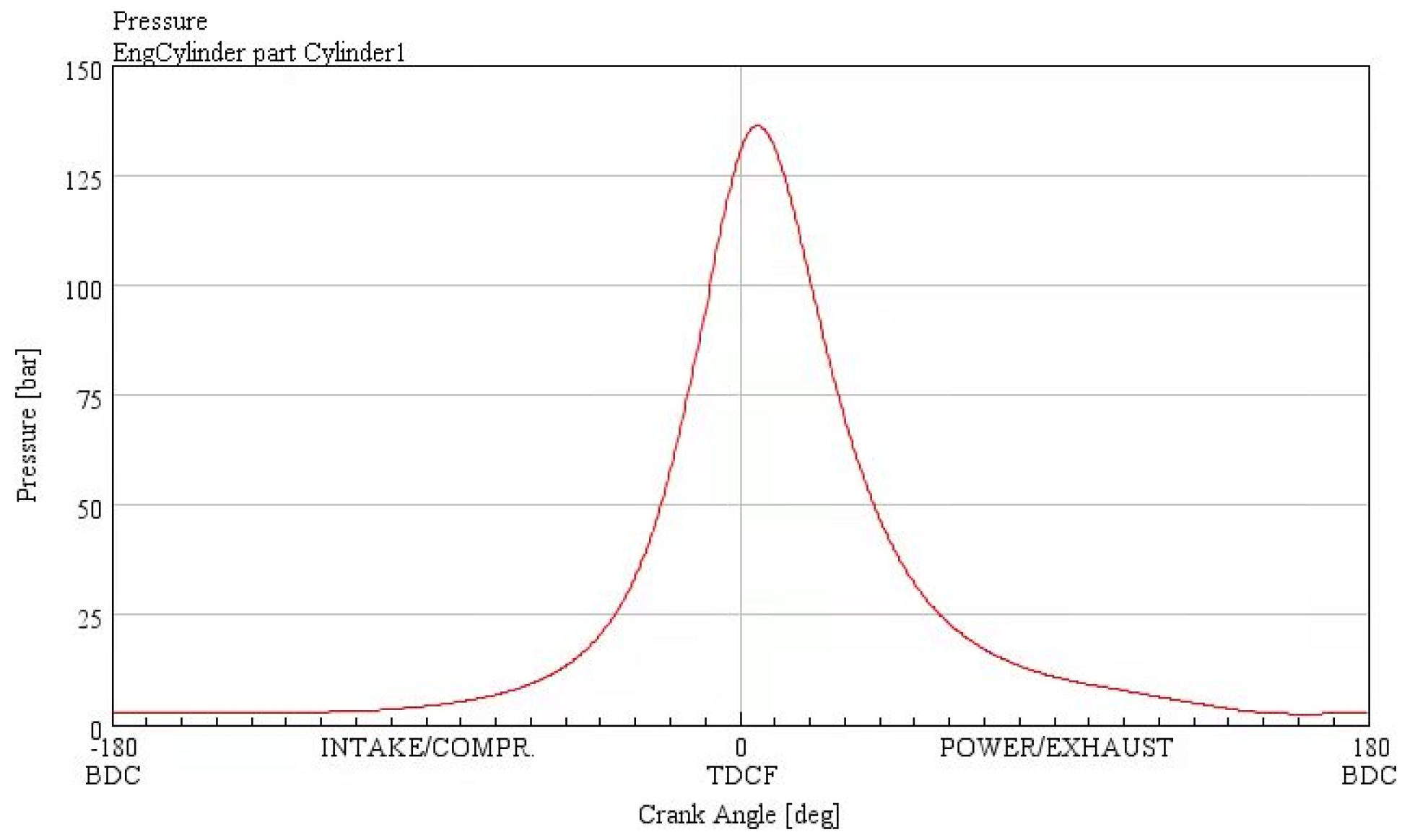

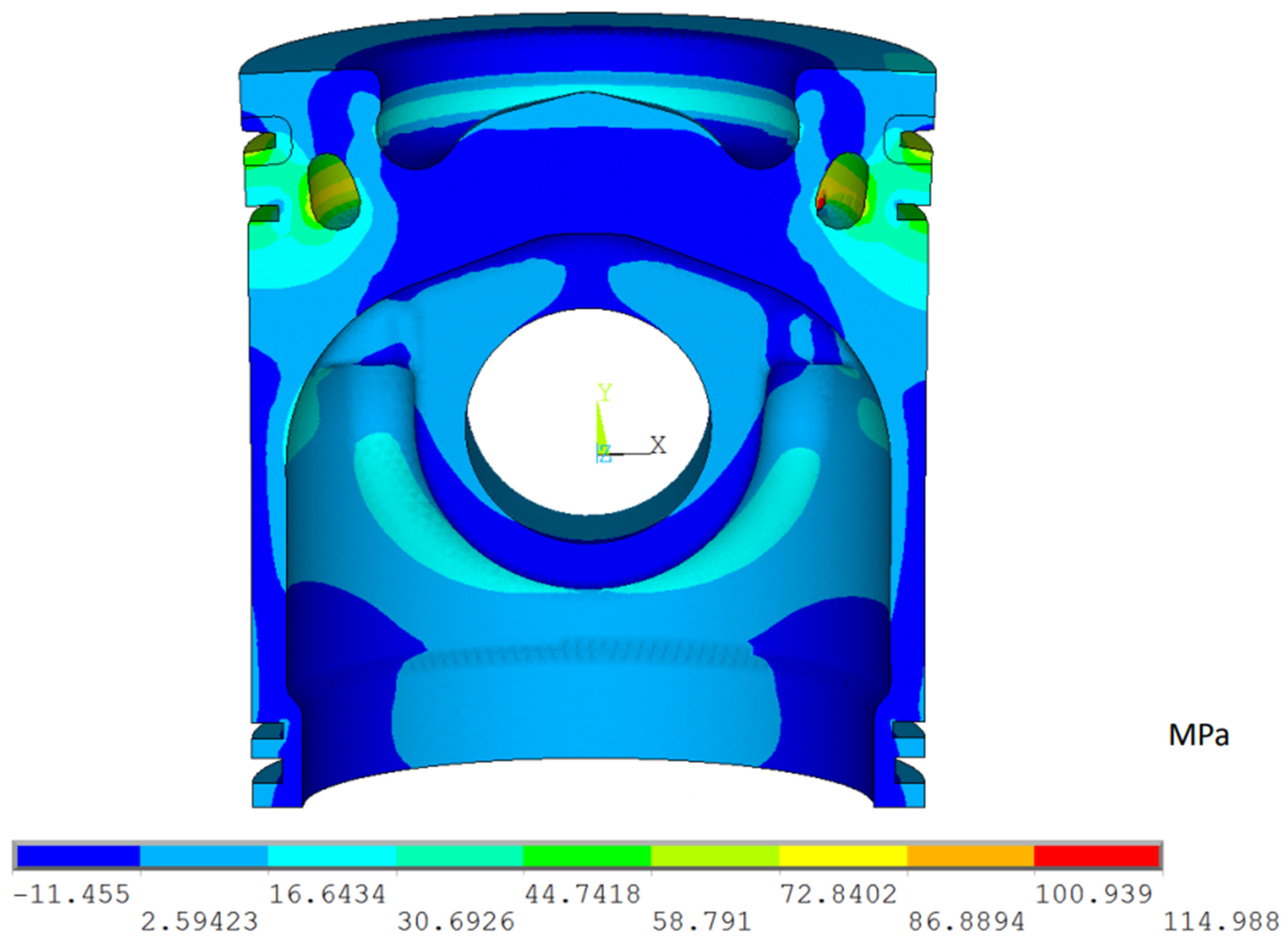


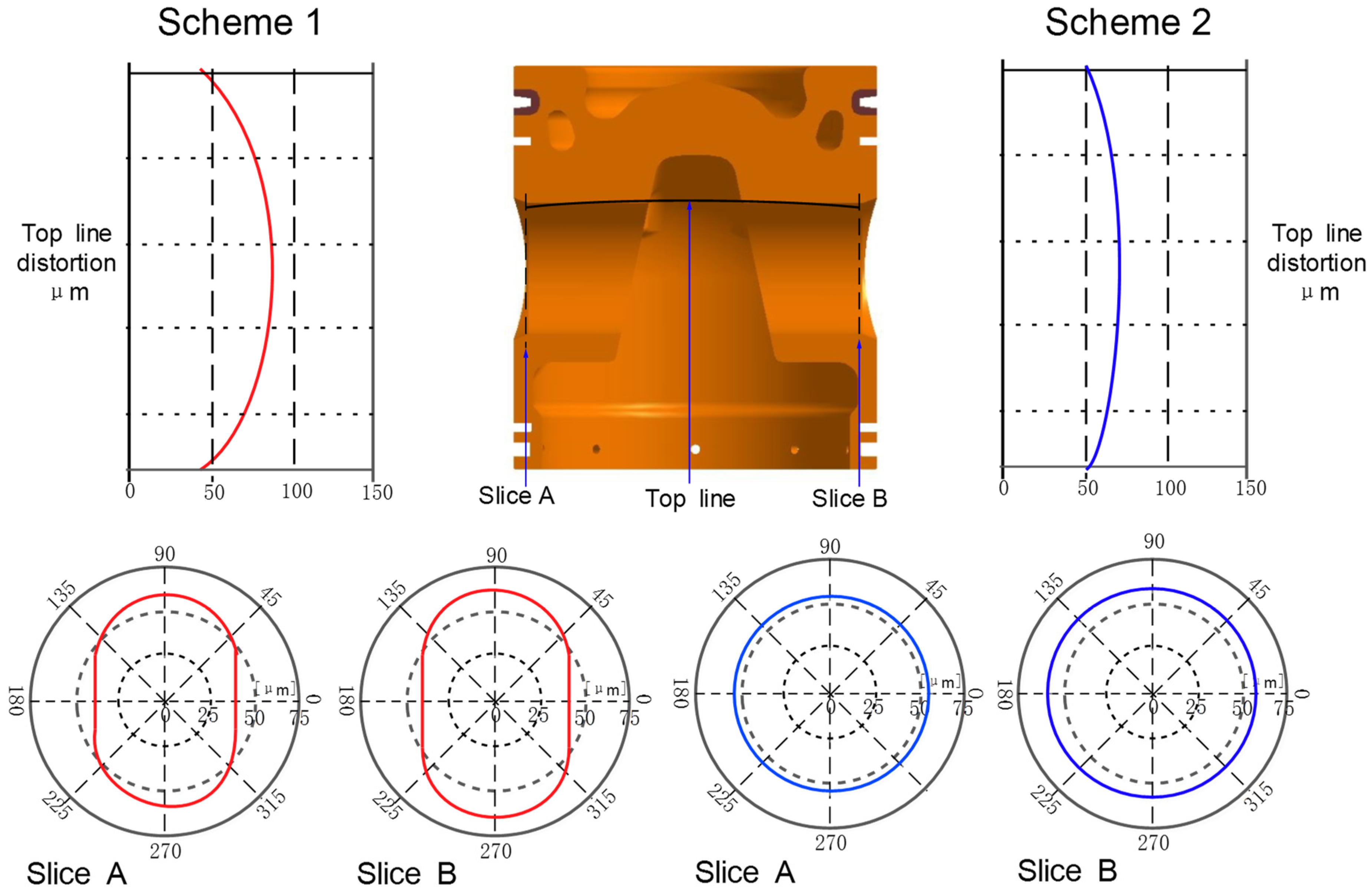
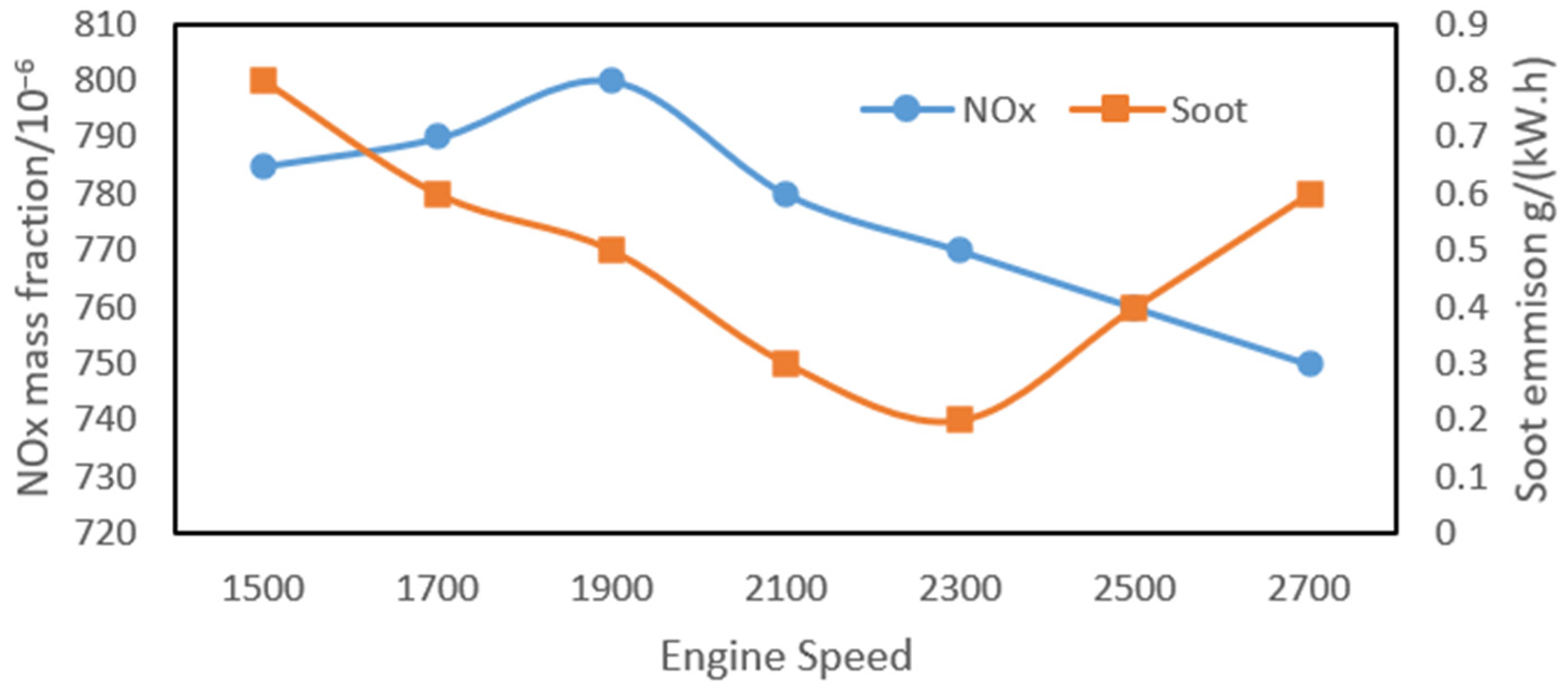
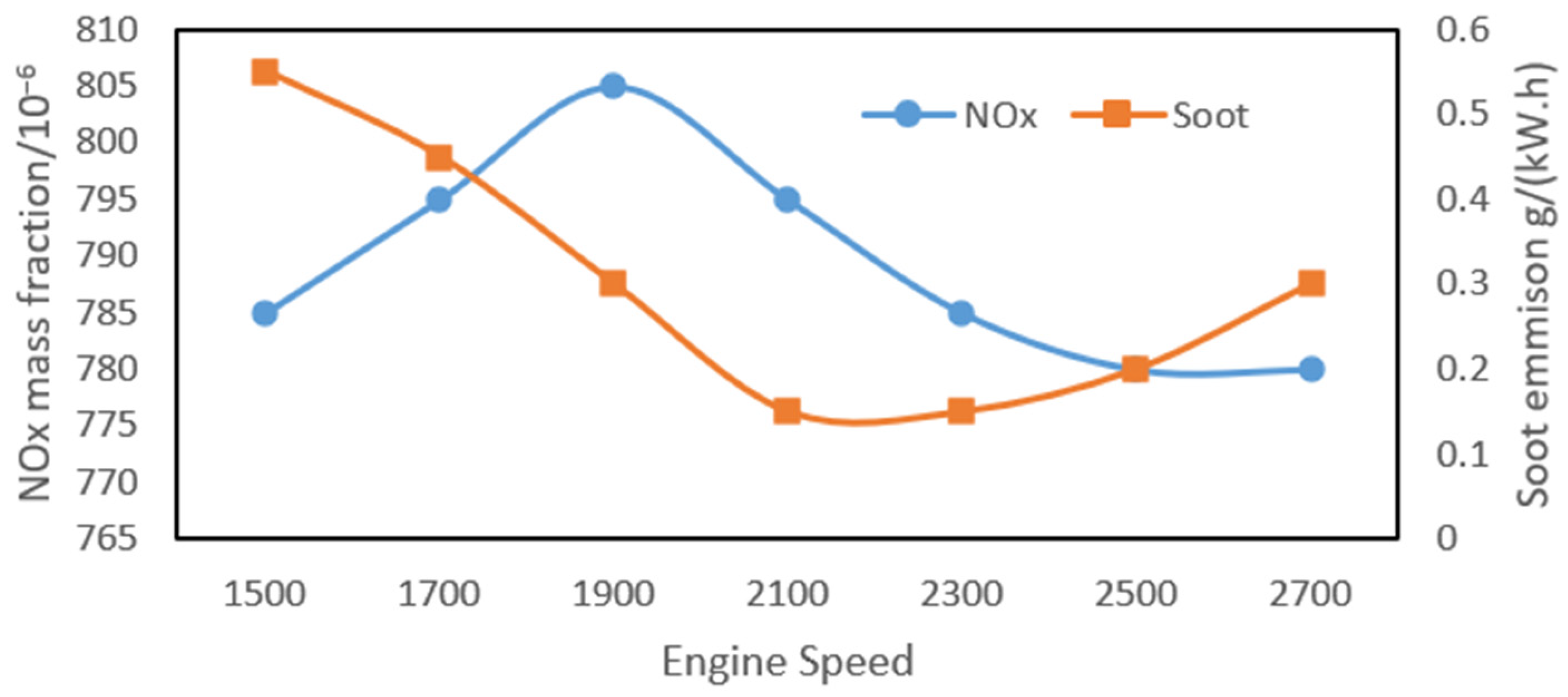

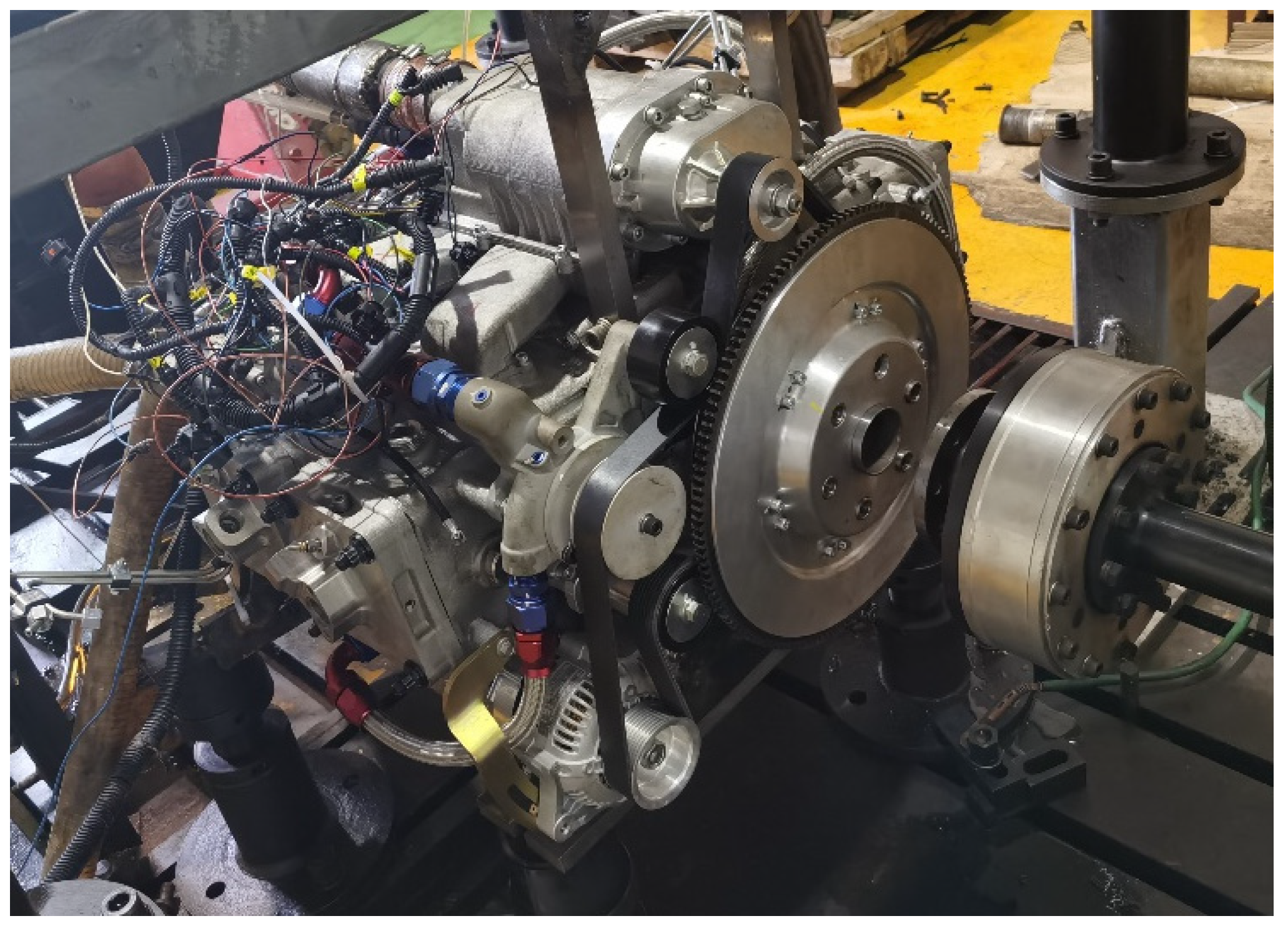
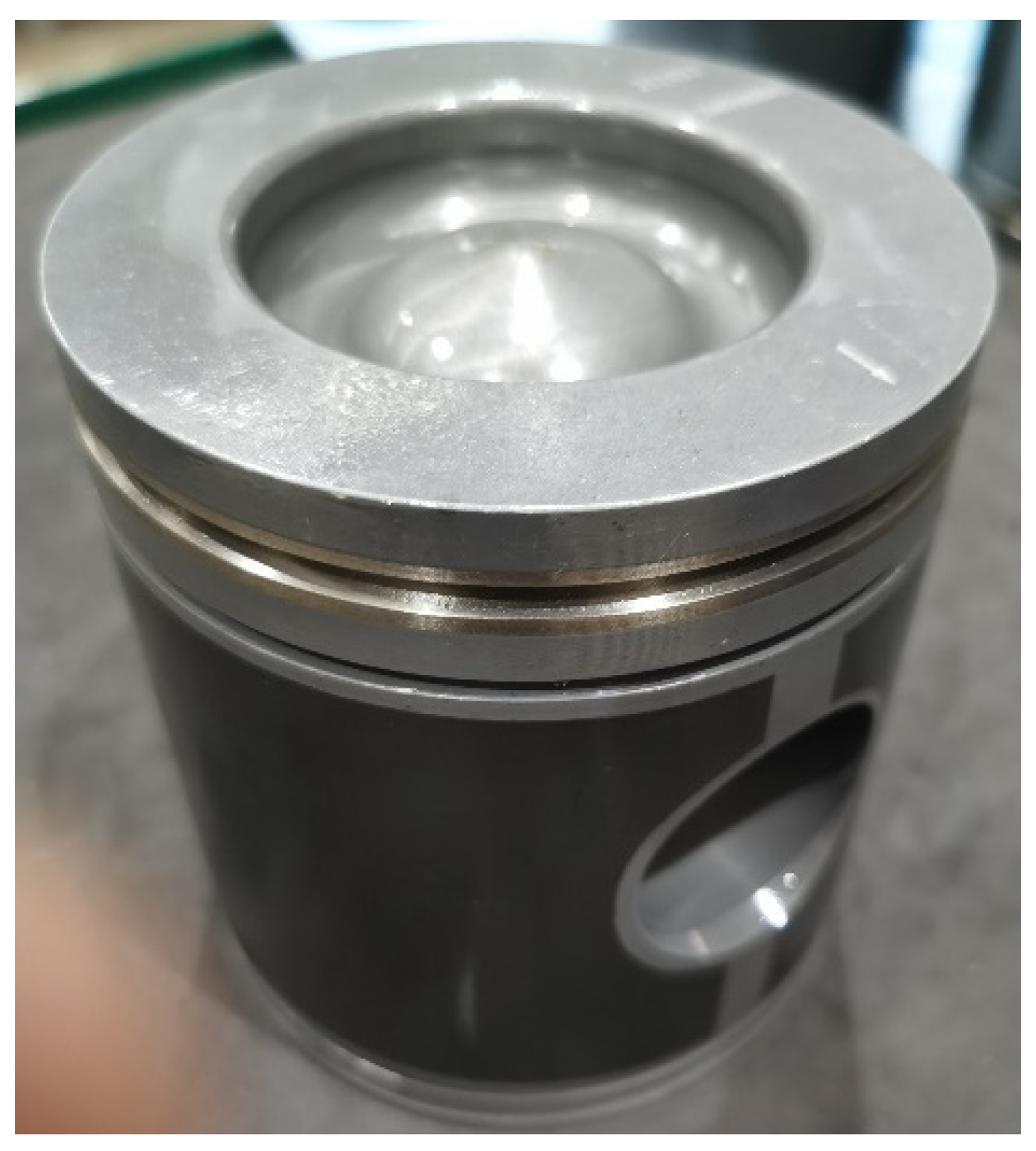
| Item | Parameters |
|---|---|
| Power | 200 HP@2700 RPM |
| Displacement | 3.5 L |
| Bore × Stroke | 105 × 102 mm |
| Fuel Consumption | 44 L/H@200 HP |
| Cruise Consumption | 32 L/H @150 HP |
| Torque | 500 N∙m@2700 RPM |
| Program | Max Diameter (D) mm | Reentrant Diameter (d) mm | Mid-Depth mm (h) | Max Depth (H) mm | Reentrant–Max Diameter Ratio (d/D) | Max Diameter–Max Depth Ratio (D/H) | Ha |
|---|---|---|---|---|---|---|---|
| scheme 1 | 51.3 | 42.4 | 8.0 | 17 | 0.83 | 3.01 | 54.5 |
| scheme 2 | 49.1 | 38 | 9.7 | 17 | 0.78 | 2.88 | 52.5 |
| Design Scheme | Max Load of Piston | Pin Bore Fatigue Deformation | Emission | Structural Efficiency |
|---|---|---|---|---|
| scheme 1 | 1.29 | 0.938 | 0.595 | 0.941 |
| scheme 2 | 1.32 | 1.25 | 0.385 | 0.985 |
| RPM | HP | N∙m | Soot/g/(kW∙h) | NOx/Mass Fraction 10−6 | ||
|---|---|---|---|---|---|---|
| Scheme 1 | Scheme 2 | Scheme 1 | Scheme 2 | |||
| 2700 | 200 | 500 | 0.59 | 0.29 | 755 | 776 |
| 2500 | 165 | 452 | 0.41 | 0.20 | 768 | 770 |
| 2300 | 150 | 420 | 0.20 | 0.19 | 772 | 781 |
| 2100 | 110 | 358 | 0.29 | 0.18 | 778 | 789 |
Publisher’s Note: MDPI stays neutral with regard to jurisdictional claims in published maps and institutional affiliations. |
© 2022 by the authors. Licensee MDPI, Basel, Switzerland. This article is an open access article distributed under the terms and conditions of the Creative Commons Attribution (CC BY) license (https://creativecommons.org/licenses/by/4.0/).
Share and Cite
Pan, Z.; He, Q.; Pang, X. Structural Efficiency Analysis of a Piston for Aviation Engines. Aerospace 2022, 9, 718. https://doi.org/10.3390/aerospace9110718
Pan Z, He Q, Pang X. Structural Efficiency Analysis of a Piston for Aviation Engines. Aerospace. 2022; 9(11):718. https://doi.org/10.3390/aerospace9110718
Chicago/Turabian StylePan, Zhongjian, Qinghua He, and Xiaobing Pang. 2022. "Structural Efficiency Analysis of a Piston for Aviation Engines" Aerospace 9, no. 11: 718. https://doi.org/10.3390/aerospace9110718
APA StylePan, Z., He, Q., & Pang, X. (2022). Structural Efficiency Analysis of a Piston for Aviation Engines. Aerospace, 9(11), 718. https://doi.org/10.3390/aerospace9110718





